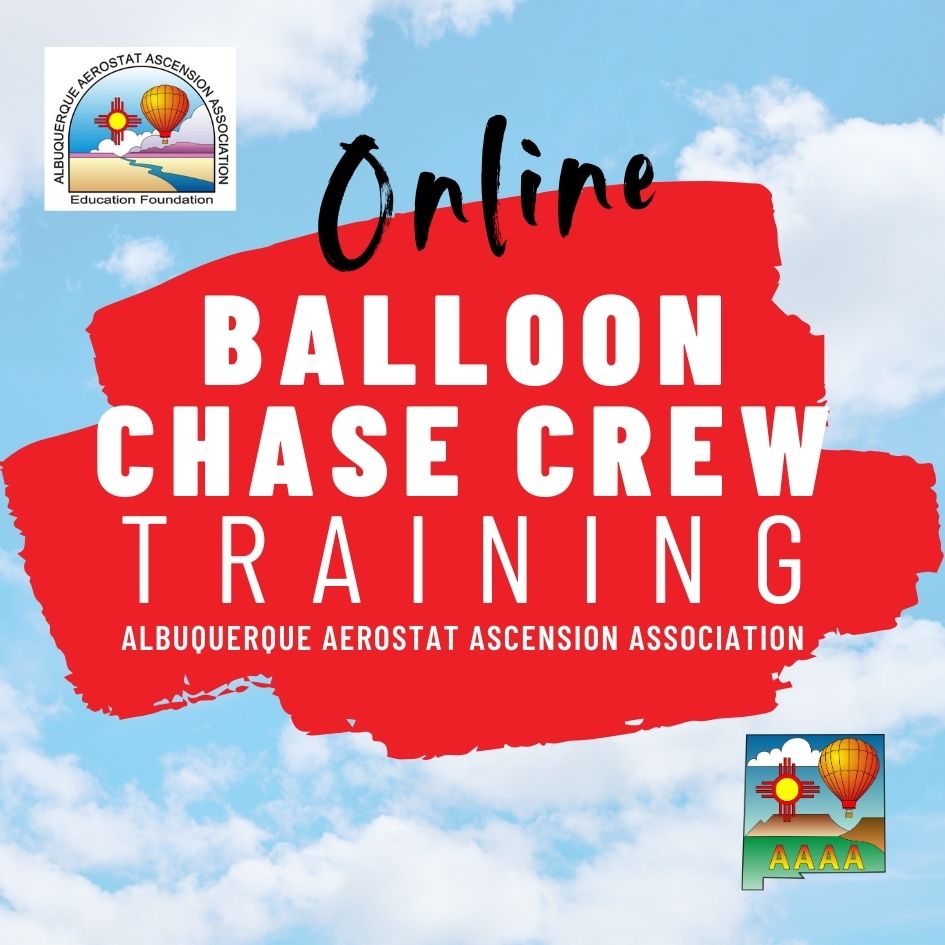Terminology
"Bag" A heavy canvas container that holds the envelope (Fabric part of the balloon). Often has a vinyl bottom for extra protection and to keep moisture away from the balloon.
"Basket" or "Gondola" Most often made of Wicker, this is the container that holds the fuel tanks, Pilot, passengers and other flight equipment.
"Burner" The Burner is more or less the engine of the balloon. A very high tech piece of equipment designed to produce heat by burning the fuel from the "Tanks".
"Bottom End" This term refers to the entire basket with fuel tanks, burner, instruments. Everything below the envelope when the aircraft is ready for launching.
"A-Block" This is the attachment on some balloons that the Flying Wires or Suspension cables attach to. The A-Block will have a quick pin that attaches the block to the basket.
"Crown Line" The rope attached to the top of the balloon. Used for inflation and deflation of the balloon.
"Carabiner" The connection device used to attach the envelop to the bottom end. Often the carabiner will have a locking mechanism to secure when attached.
"Drop Line" A rope or coil of webbing the pilot can drop to the ground team for assistance in making a precise landing or in a confined space where the balloon needs directional assistance.
"Envelope" The fabric part of the balloon. The envelope is the part of the balloon that contains the heated air required for flight.
"Equator" This is the largest part of the balloon. The equator of the balloon is more or less the middle section or widest part of the envelope.
"Going Hot" The point where the pilot is ready to add heat to the envelope. Sometimes refereed to standing up the balloon. This is the most delicate portion of the inflation process.
"Gore" A gore is the strip of fabric from the top (crown) of the balloon to the bottom of the balloon. A gore can be made up of many panels or one continuous piece of fabric.
"Load Block" This is the attachment point on the basket where the envelope suspension lines attach.
"Mouth" This is the opening at the bottom of the balloon where the flame from the burner shoots into the balloon. The mouth of the balloon is also refereed to as the throat of the envelope.
"Hands-Off" Often used with the word "Release". this means that you are to let go of the basket. Pilots may do this one person at a time so make sure you are the one who has been instructed to "Hands Off"
"Hands-On" The pilot is asking for you to place your hands on the basket and await further instructions. This may be used for moving an inflated balloon or to guide a basket to a different location.
"Inflation" The process of inflating a balloon. Inflation is a process where the entire team works together to prepare the balloon for flight.
"Inflation Fan" A motorized fan used to fill the envelope with air. The inflation fan is considered one of the most dangerous pieces of equipment used.
"Load Tape(s)" A piece of webbing (normally 1") that is stitched on both horizontal and vertical seams on the balloon. The name comes from the fact that this webbing is the framework of the balloon and caries the weight of the bottom end.
"Panel" A horizontal piece of fabric that makes up the gore of the balloon. There may be as many as 30 panels in a gore.
"Parachute" The Plug at the top of the balloon that holds air in the balloon until the pilot opens the parachute to release air. This is done to maneuver the balloon and to deflate the balloon.
"Quick Release" A safety tie off from the basket to an anchor such as a tree, vehicle, trailer or another object that does not move easily. The quick release is activated when the pilot is ready to lift off.
"Red Line" This line runs directly to the deflation system on the balloon. The red line is only used when it is time to deflate the balloon.
"Scoop" A scarf like collar that covers around half of the throat of the balloon. The scoop helps direct any cross wind up into the balloon to help pressurize the envelope. A scoop is only useful when the balloon is being held stationary on the ground.
"Skirt" The collar around the mouth of the balloon. The skirt helps protect the flame from the burner when a balloon is in flight. As the balloon goes up and down it may encounter cross winds (winds moving different directions to the path of the balloon) that could push the flame close enough to the envelope to cause damage.
"Suspension Lines" These are the wires that connect the envelope (Balloon) to the basket. They can be stainless steel or Kevlar. Often attached with a carabiner or an "A-Buckle" to the Load Block or Load Cables.
"Tanks" The container on board that holds the fuel for the balloon. Propane is the fuel that is carried on board for sustaining the aircraft in flight.
"Throat" The opening at the bottom of the envelope. This is where the air from the inflation fan is pushed during inflation and where the pilot shoots the flame from the burner.
"Tether" The process of holding the balloon in a stationary position or location using a series of ropes anchored to heavy or unmovable objects. A tether normally consists of three ropes holding the balloon still.
"Tie-Off" A safety device used to anchor the balloon in one spot.
"Weight-On" Placing as much of your body weight on the basket of the balloon to hold it still
"Weight-Off" To release the weight on the basket.
"Vent Line" Used to partially open the top of the balloon to valve off some of the heat in the balloon.
Overall Crew Guidelines
WHILE ON THE FIELD
- Take directions from only the Pilot or the Crew Chief
- Do not smoke near the balloon. The Balloon is fueled with propane which can ignite. Cigarette ashes and butts can melt holes in the balloons fabric.
- Do not step on the balloon fabric!! If you step on the envelope and there's a small rock or twig beneath your foot, it can pierce through the fabric and create a hole.
- Handle the envelope only by the loadtapes. Do not grab or pull on the fabric
- Do not wrap ropes around your hands or any part of your body. If you can't hang onto a rope, then let it go.
LAUNCHING THE BALLOON
- Listen to your pilot and follow all directions. Alert the pilot or other crew members if you have any concerns.
- During the launch, stand at the side or back of the basket. Never stand directly in front of the balloon's flight path.
- Never take your feet off the ground.
- Be sure that all equipment is secured in the chase vehicle before leaving the area.
- Make one last scan of the launch area to ensure you or anyone has left items in the field.
DURING THE CHASE
- If you are assigned to drive the chase vehicle, keep your eyes on the road. Rely on the navigator to track the balloon.
- Obey all traffic laws. The chase vehicle receives no special privileges.
- Drive on roads parallel (as best you can) to and slightly ahead of the balloon's flight path.
- Do not drive into public parks, schoolyard lawns, golf courses, grassy ball fields or other sites where the balloon chase vehicle could damage the property or get stuck.
- When communicating with the pilot over the radio, keep the transmissions brief. Let the pilot initiate communications.
- Never try to contact (and, therefore, distract) the pilot during landings. Unless you see a potentially dangerous situation. Even then communicate to the Crew Chief and allow them to contact the pilot.
- No one under the age of 21 may ride in the back of an open pickup truck.
- Do not sit on the truck's side rails or tailgate.
- Open alcoholic beverages are not permitted in the chase vehicle while on a public highway.
RECOVERING THE BALLOON
- Park the chase vehicle out of the way of traffic
- Wait until the vehicle comes to a stop before jumping out.
- Remain clear of the balloon's flight path. Stay to the sides and rear of the basket during landing.
- When grabbing onto the basket, be sure to keep your feet on the ground. If the balloon starts to climb let go of it immediately!
LANDOWNER RELATIONS
- It is sometimes necessary to land on private property. Thus, good landowner relations are essential to ballooning. It is important that you help make the landowner's experience a positive one.
- Always be courteous and friendly.
- If at all possible, obtain permission before driving the chase vehicle onto private property.
- Be aware of and respect any pets, livestock and vegetation.
- Keep spectators out of the area unless the landowner is present and has given permission.
- Do NOT cut fences or force locks to obtain entry. Make sure that fences and gates are always closed.
- If a dispute arises with the landowner, the pilot will intervene. Pilots will be responsible for any consequences from a landowner dispute.
POWER LINE SAFETY
- Among the most serious hazards in ballooning are power lines. If the balloon should collide with power lines, it is critical that you follow these procedures.
- Do not try to bring down the balloon. If it is hanging on the wires. You can endanger yourself as well as the pilot and passengers. Always assume the wires are charged unless someone from the power company can confirm they are not live.
- Stay at least 100 feet away from downed lines or the balloon. If any part of it is in contact with the power lines and the ground.
- Your priority is to call 911 or your local power company immediately. Describe as specifically as you can the location of the balloon. Give street intersections and/or the number on the power pole nearest to the balloon.
- Let the pilot and passengers know help is on the way. They should stay in the basket until help arrives and they are informed it is safe to exit the balloon.
- Keep the crowd under control and away from the balloon and power lines.
Sequence of events
Pilot Briefing
At formal events a Pilot Briefing is held to inform pilots of important procedures, events, concerns, tasks and weather conditions for the flight. While the pilot is attending the briefing the crew chief will advise the crew and passengers.
pilots of important procedures, events, concerns, tasks and weather conditions for the flight. While the pilot is attending the briefing the crew chief will advise the crew and passengers.
Crew Brief
Many pilots will conduct a pre-flight briefing with 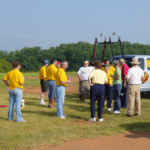 the ground team. This briefing may include the assignments of crew positions, special concerns, weather advisory and any other safety issues the pilot deems needed. The ground team is encouraged to ask questions should anything be unclear.
the ground team. This briefing may include the assignments of crew positions, special concerns, weather advisory and any other safety issues the pilot deems needed. The ground team is encouraged to ask questions should anything be unclear.
Rigging and Assembly
Assembly of the bottom end includes mounting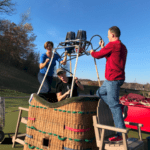 uprights, burner frame or burner, fuel lines, Upright covers. Connecting fuel lines, Quick Release, and envelope flying wires to the basket.
uprights, burner frame or burner, fuel lines, Upright covers. Connecting fuel lines, Quick Release, and envelope flying wires to the basket.
Cold Inflation
The throat (mouth) of the balloon is held open 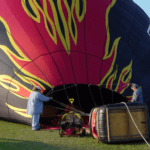 and the inflation fan started. The crown line is laid out on the ground and the parachute rigged. All internal lines, vents and envelop is examined for any potential issues. Once all is in order the pilot will begin the next phase of the inflation
and the inflation fan started. The crown line is laid out on the ground and the parachute rigged. All internal lines, vents and envelop is examined for any potential issues. Once all is in order the pilot will begin the next phase of the inflation
Going HOT
The pilot will light the burners pilot lights and 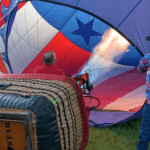 begin to add heat to the envelope. As the air in the balloon is heated the balloon will begin to stand up. The ground crew on the mouth of the balloon will move to a hands on position on the gondola.
begin to add heat to the envelope. As the air in the balloon is heated the balloon will begin to stand up. The ground crew on the mouth of the balloon will move to a hands on position on the gondola.
The Launch
The pilot completes the final pre-flight checks, 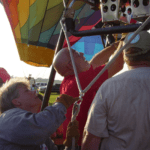 passengers are invited to get into the basket. The inflation harness (quick release) is detached and the flight begins.
passengers are invited to get into the basket. The inflation harness (quick release) is detached and the flight begins.
Flight
The balloon moves with the wind. As the balloon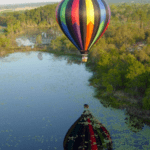 launches it will gradually pick up and match the speed of the wind. Because of this there is little sense of motion at all. You will be warmer in the basket because of the radiant heat of the burner and the fact that you are floating with the wind so there will be no wind chill feeling. On the average you will feel 8-10 degrees warmer in the balloon.
launches it will gradually pick up and match the speed of the wind. Because of this there is little sense of motion at all. You will be warmer in the basket because of the radiant heat of the burner and the fact that you are floating with the wind so there will be no wind chill feeling. On the average you will feel 8-10 degrees warmer in the balloon.
Landing
The landings vary quite dramatically from flight to flight. The two biggest factors on landing are 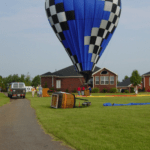 the speed of the wind and the size of the landing area. High winds or small landing areas can make for rough landings. You should ALWAYS hold on very tightly for every landing. Bend your knees slightly and listen for additional instructions from your pilot. DO NOT get out of the basket until instructed to do so by your pilot.
the speed of the wind and the size of the landing area. High winds or small landing areas can make for rough landings. You should ALWAYS hold on very tightly for every landing. Bend your knees slightly and listen for additional instructions from your pilot. DO NOT get out of the basket until instructed to do so by your pilot.
Disassembly and Pack up
The pilot will deflate the balloon and the ground team will squeeze the extra air out of the 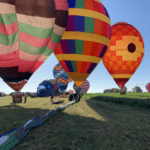 envelope. The envelope is detached from the bottom end. The balloon is stuffed into the envelope bag and all the components (burner, instruments, uprights and covers) are disassembled and stored away.
envelope. The envelope is detached from the bottom end. The balloon is stuffed into the envelope bag and all the components (burner, instruments, uprights and covers) are disassembled and stored away.
Flight Review
After the flight the pilot may conduct a flight 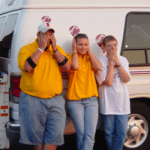 review. It is at this time any concerns or questions about the flight can be discussed. Generally flight reviews are conducted by the pilot and ground team only. This is after the passengers have left.
review. It is at this time any concerns or questions about the flight can be discussed. Generally flight reviews are conducted by the pilot and ground team only. This is after the passengers have left.


